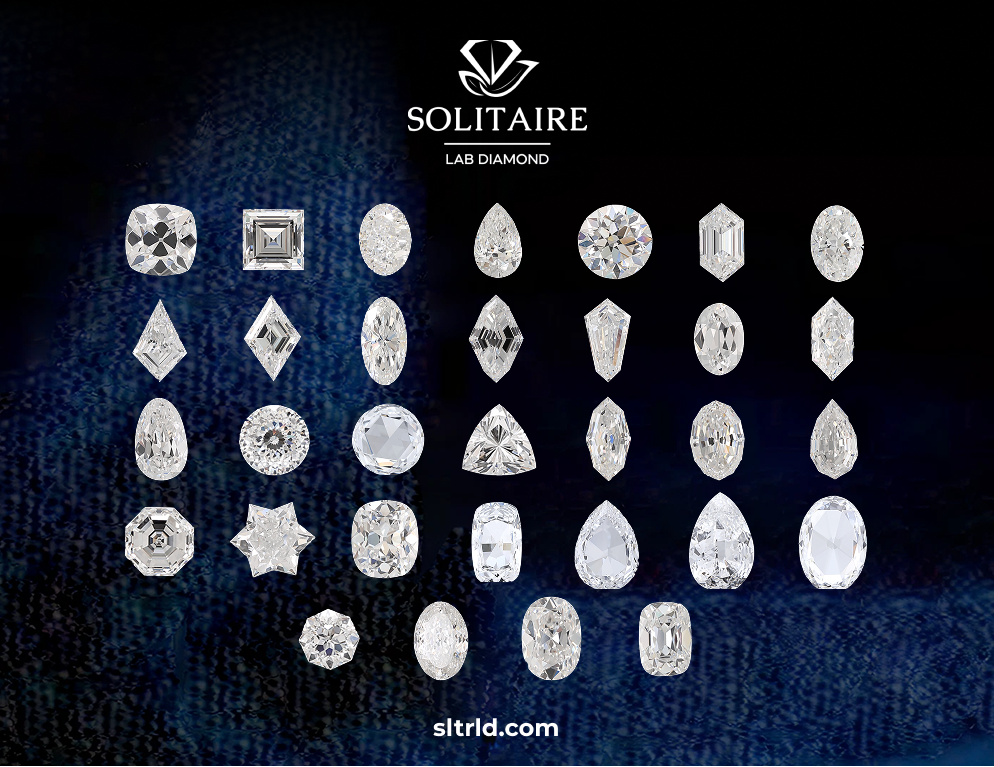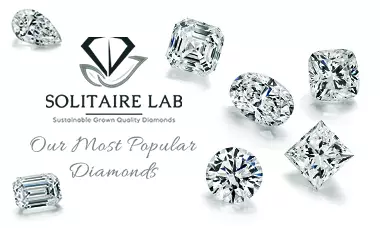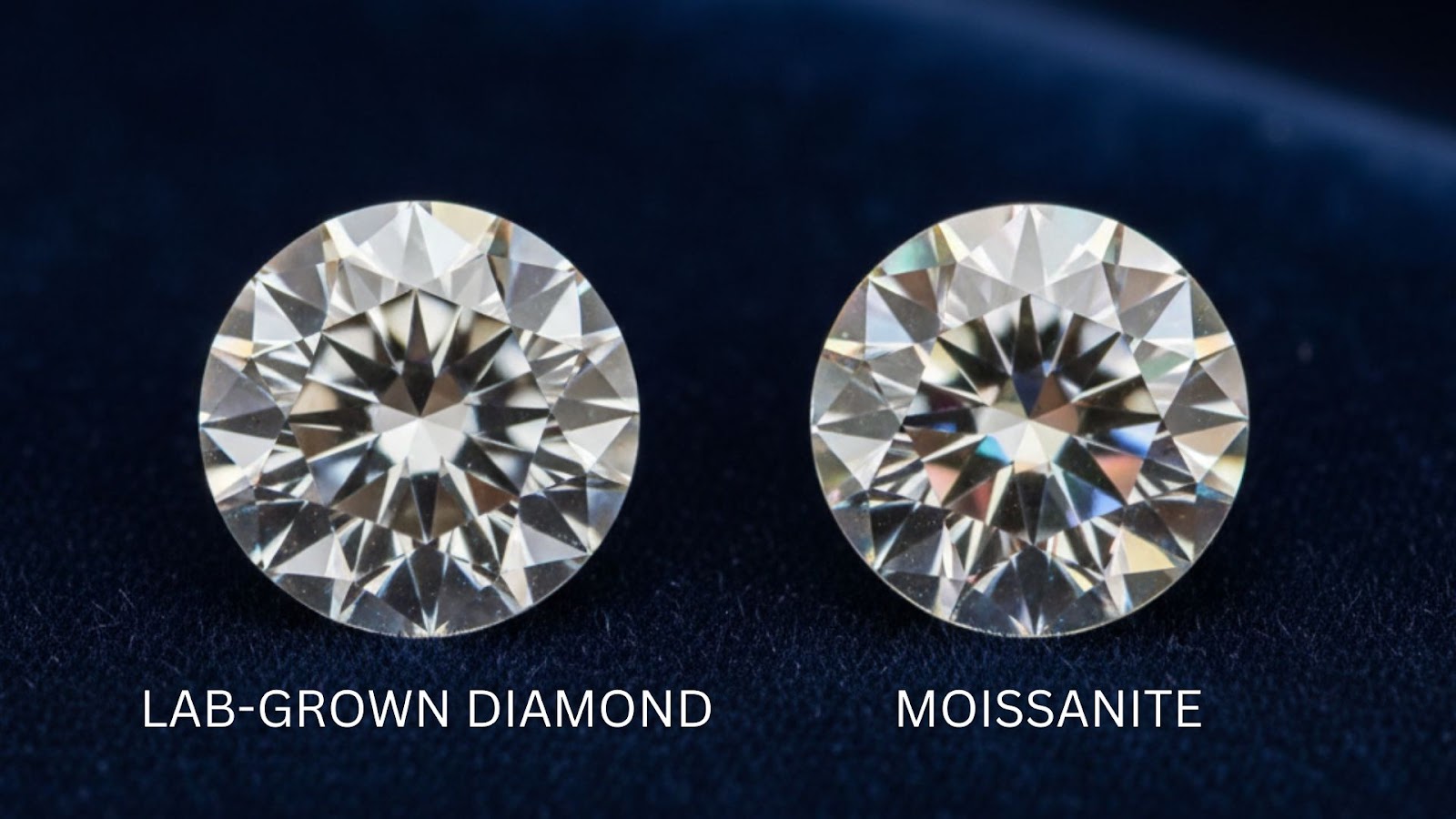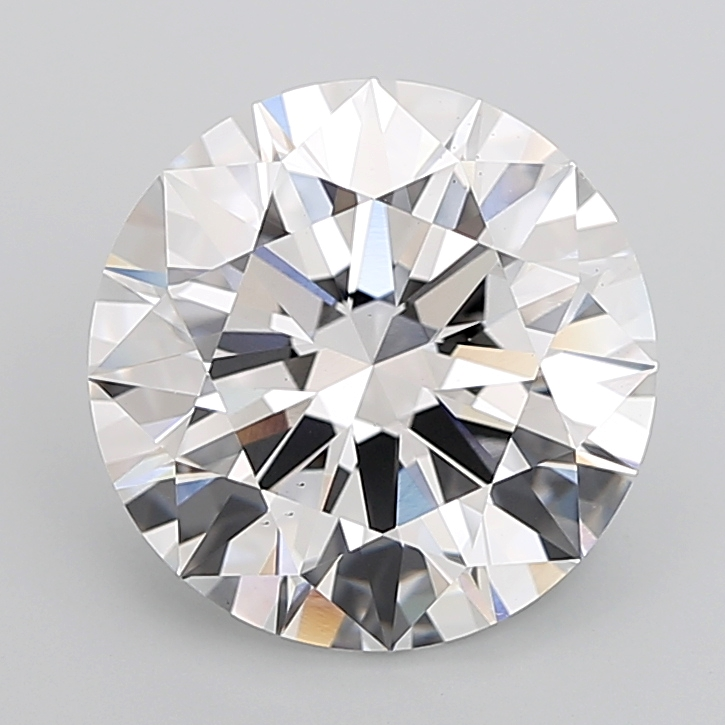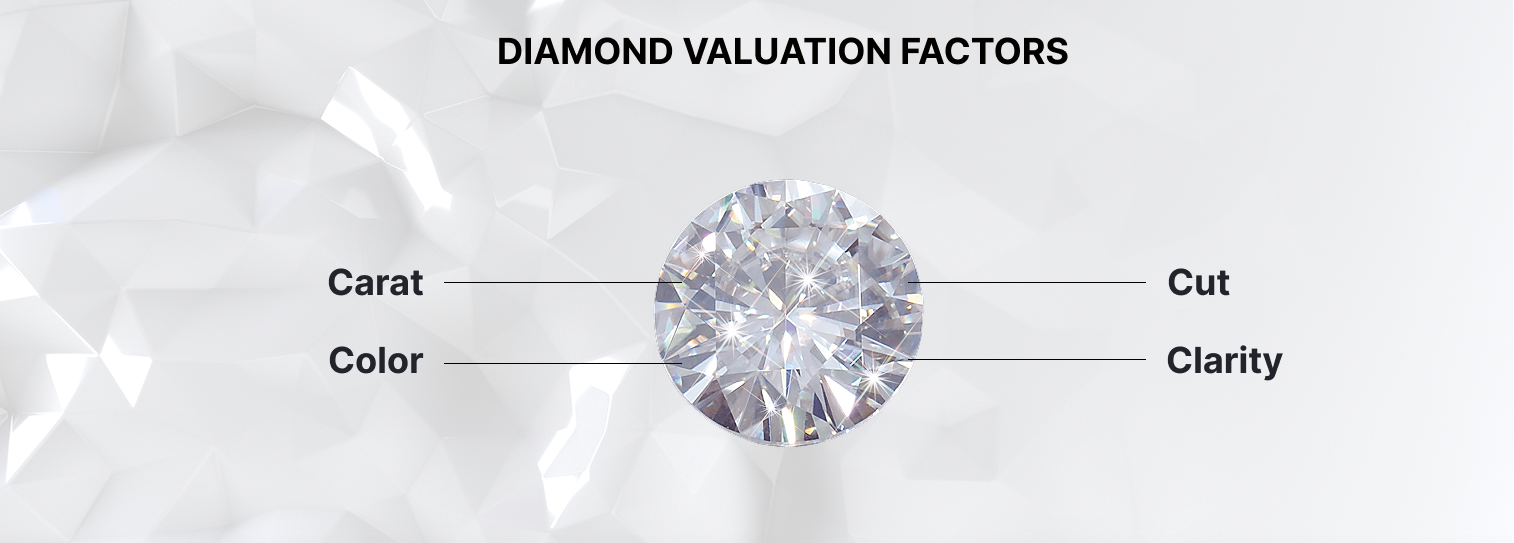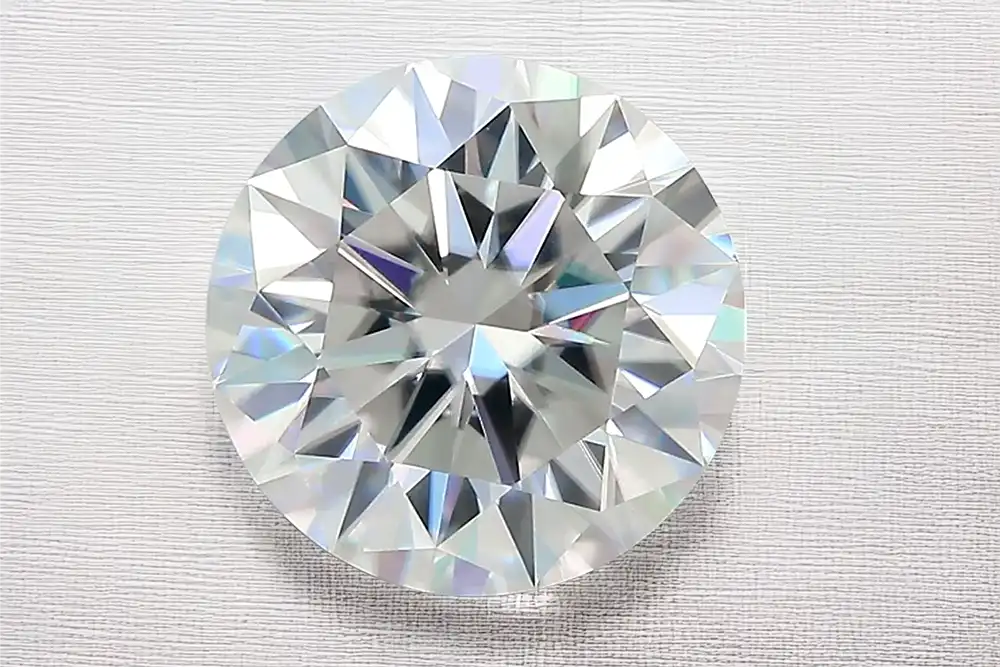Choosing between lab grown diamonds vs moissanite can be confusing because both stones look similar and offer a sparkling, affordable alternative to mined diamonds.
While they may appear alike, they differ in important ways, such as durability, brilliance, and long-term value. Lab grown diamonds have the same chemical and physical properties as natural diamonds, whereas moissanite has a unique shine and hardness of its own.
Understanding these differences is crucial for making a choice that suits your style, budget, and the type of jewelry you want.
This guide explains the key factors to consider when deciding between lab grown diamonds and moissanite.
What Are Lab Grown Diamonds?
Lab grown diamonds are real diamonds created in controlled laboratory environments instead of being mined from the earth.
Scientists use advanced methods like Chemical Vapor Deposition (CVD) or High Pressure High Temperature (HPHT) to replicate the natural conditions that form diamonds deep within the Earth’s crust. These diamonds are chemically, physically, and optically similar to mined diamonds. Lab-grown diamonds are made of pure carbon crystals and have the same hardness, brilliance, and fire as natural diamonds.
They are graded using the same 4Cs (cut, color, clarity, and carat) system and are certified by leading gemological institutes.
In addition to being authentic, lab-grown diamonds are an ethical and sustainable choice. They avoid the environmental damage and labor concerns associated with mining, making them a popular option for socially conscious buyers.
If you are interested in learning more about lab grown vs natural diamonds, we have covered the comparison in detail.
What Is Moissanite?
Moissanite is a diamond simulant made of silicon carbide, known for its fiery, rainbow-like sparkle and high durability (9.25 Mohs) at a lower price point than diamonds. Originally discovered in 1893 by French scientist Henri Moissan in an Arizona meteor crater. Natural moissanite is extremely rare, making it a truly special gem.
However, today, almost all moissanite used in jewelry is lab-created, making it both affordable and accessible.
Unlike diamonds, moissanite is composed of silicon carbide rather than carbon.
This fundamental difference in chemical structure gives moissanite its distinctive properties, including exceptional brilliance and a characteristic rainbow-like sparkle often described as "fiery."
Its lab-created nature ensures consistency in quality, and its durability makes it suitable for everyday wear.
Most importantly, moissanite offers exceptional value, typically costing a fraction of what you would pay for a diamond of comparable size.
Lab Grown Diamonds vs Moissanite: Key Differences
When weighing lab grown diamonds vs moissanite, several critical factors distinguish these two popular gemstones. Here's a quick comparison:
|
Feature |
Lab Grown Diamonds |
Moissanite |
|
Composition |
Pure carbon |
Silicon carbide |
|
Hardness (Mohs Scale) |
10/10 |
9.25/10 |
|
Sparkle Type |
Classic brilliance |
Rainbow fire |
|
Price Range |
Higher |
Much lower |
|
Symbolism |
Timeless tradition |
Modern alternative |
Now let’s understand each factor in detail.
1. Composition & Origin
The origin of a gemstone shapes its properties and value. Lab-grown diamonds are made of pure crystallized carbon, sharing the same atomic structure as natural diamonds. This makes them true diamonds in every scientific sense, with the same hardness, durability, and overall performance.
Moissanite, on the other hand, is composed of silicon carbide, a completely different mineral. While it resembles a diamond in sparkle and appearance, it has its own unique brilliance, fire, and characteristics.
This difference in composition affects everything from how the stone interacts with light to its valuation in the market, making each gem distinct despite visual similarities. The shape you choose will also impact the overall appearance.
Check out our diamond shapes chart to see how different cuts work with various gemstones.
2. Appearance & Sparkle
How a gemstone shines can make a huge difference in its appearance.
Lab-grown diamonds have the classic sparkle that people usually visualize when they imagine a diamond. They reflect mostly white light with just a minimal rainbow flash, giving a subtle and elegant shine.
Moissanite, on the other hand, reflects rainbow colors and flashes, creating a brighter and more eye-catching sparkle. Some people love this bold look, while others prefer the softer, traditional shine of a diamond.
In the end, it comes down to which type of sparkle you like best.
3. Hardness & Durability
On the Mohs hardness scale, diamonds rank as the hardest naturally occurring substance at 10 out of 10. Lab grown diamonds maintain this perfect score, making them incredibly resistant to scratching and ideal for jewelry worn daily, like engagement rings.
Moissanite scores 9.25 on the Mohs scale, making it the second-hardest gemstone commonly used in jewelry. While slightly softer than diamonds, moissanite is still exceptionally durable and more than capable of withstanding everyday wear.
For practical purposes, both stones offer excellent longevity.
4. Color & Clarity
The color and clarity of a gemstone affect how it looks and sparkles.
Lab grown diamonds are graded just like natural diamonds, with colors ranging from D, which is completely colorless, to Z, which shows light yellow or brown tones. Their clarity is also graded from Flawless to Included, making it easy to know the quality of each stone.
Moissanite is usually near-colorless, but it can sometimes show slight yellow or gray tints, especially in larger stones or certain lighting.
For most people, these small color differences are hardly noticeable, particularly in smaller stones.
5. Price
Price is one of the biggest differences between lab-grown diamonds and moissanite.
Lab grown diamonds are consistently more affordable than natural diamonds, often costing 60-80% less, but are still more expensive than moissanite. A one-carat lab grown diamond can range from around $800 to $2,500, depending on its quality.
However, a similarly sized moissanite stone typically costs between $400 and $600.
For shoppers on a budget, moissanite offers great value, allowing you to get a bigger stone or spend more on the setting.
6. Symbolism & Perception
The meaning behind a gemstone can be just as important as its look.
Diamonds have long represented love, commitment, and status, and lab-grown diamonds carry all of this meaning while also reflecting modern values like sustainability and ethical sourcing.
Moissanite, while stunning and practical, does not have the same history or cultural weight. Many people see it as a smart, modern choice that focuses on value and quality, but others feel it may not carry the same emotional significance for precious jewelry piece like engagement rings.
Lab-Grown Diamonds vs. Moissanite: Pros and Cons
When choosing between lab-grown diamonds and moissanite, understanding their strengths and weaknesses can help you make the right decision.
Lab-Grown Diamonds
Here are the advantages and disadvantages to consider before buying lab-grown diamonds
|
Pros |
Cons |
|
Similar properties to mined diamonds |
More expensive than moissanite |
|
Carry traditional diamond symbolism and prestige |
Lower resale value compared to natural diamonds |
|
Certified and graded by trusted gemological institutes |
High-quality, larger stones require a bigger budget. |
|
Hold better resale value than moissanite |
|
|
Ethical and eco-friendly choice |
Moissanite
Here are the advantages and disadvantages to consider before buying moissanite
|
Pros |
Cons |
|
More budget-friendly for bigger stones. |
Not similar to real diamond |
|
Very sparkly with unique rainbow-like fire |
Does not carry the same traditional prestige as lab-grown diamonds |
|
Durable and suitable for everyday wear |
Rainbow sparkle may not appeal to everyone |
|
Lab-created, consistent, and ethically sourced |
Minimal resale value |
|
No environmental impact from mining |
Certain sizes or lighting may show slight color tints |
Thus, lab-grown diamonds are best for those who value authenticity and tradition, while moissanite is a smart, affordable, and ethically conscious choice with extra sparkle.
Making Your Choice with Solitaire Lab Diamond
Both lab-grown diamonds and moissanite have their advantages, but the best choice depends on what you value most. Lab-grown diamonds are ideal if you want a genuine diamond with timeless beauty, lasting value, and ethical sourcing.
They offer the same chemical composition, hardness, and classic sparkle as mined diamonds, without the environmental or ethical concerns of traditional mining.
This makes them perfect for engagement rings, anniversary gifts, or any special jewelry piece where quality and tradition matter.
Solitaire Lab Diamond offers certified, ethically sourced lab-grown diamonds. Our team can guide you through the selection process, explain certifications, and help you choose a diamond that fits your style and budget.
Opting for a lab-grown diamond combines elegance, reliability, and sustainability. Contact Solitaire Lab Diamond for consultation and discover how accessible genuine luxury can be.
Your perfect lab-grown diamond is waiting, and we are here to help you find it :)
